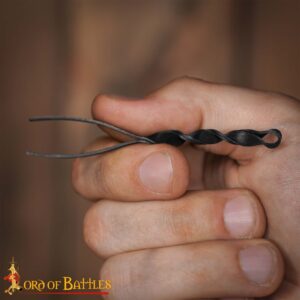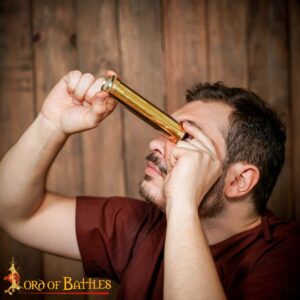$9.99
16 in stock
Authentic Medieval Design – Inspired by original finds, perfect for reenactments and historical costumes.
Durable Brass Construction – Made from solid brass for strength, longevity, and resistance to rust.
Set of 6 Pins – Each pin measures approx. 4 cm (1.5 in) with a 0.6 mm thickness.
Versatile Use – Ideal for fastening garments and accessories, or as a collectible display.
Handcrafted Detail – Each pin has slight variations, showcasing traditional craftsmanship.
Get a chance to walk back into past with this Medieval Brass Sewing Pin Set, made to recreate the small but important tools used by men and women in medieval times. Pins like these were common in households, used for fastening clothes, securing veils, or as everyday sewing tools.
This set comes with 6 brass pins, each with a coiled loop head inspired by historical designs.
Crafted from solid brass, these brass sewing pins resist rust and keep a warm golden color, offering both durability and charm. Whether for medieval reenactments, LARP outfits, or your sewing kit, this set adds both function and authenticity.
Each pin is hand-finished, giving subtle differences that make your set unique and historically accurate. Small yet strong, they are an essential accessory for anyone who loves medieval history, costuming, or reenactments.
Measurements (Approx.):
Thickness: 0.6 mm
Overall Length: 4 cm (1.5 in)
Care Instructions:
Store in a dry place to prevent tarnish.
Polish with a soft cloth to keep shine.
Avoid bending to maintain strength.
Notes:
The Brass Sewing Pins are handcrafted in nature, so minor variations in size and finish may occur.














Get a chance to walk back into past with this Medieval Brass Sewing Pin Set, made to recreate the small but important tools used by men and women in medieval times. Pins like these were common in households, used for fastening clothes, securing veils, or as everyday sewing tools.
This set comes with 6 brass pins, each with a coiled loop head inspired by historical designs.
Crafted from solid brass, these brass sewing pins resist rust and keep a warm golden color, offering both durability and charm. Whether for medieval reenactments, LARP outfits, or your sewing kit, this set adds both function and authenticity.
Each pin is hand-finished, giving subtle differences that make your set unique and historically accurate. Small yet strong, they are an essential accessory for anyone who loves medieval history, costuming, or reenactments.
Measurements (Approx.):
Thickness: 0.6 mm
Overall Length: 4 cm (1.5 in)
Care Instructions:
Store in a dry place to prevent tarnish.
Polish with a soft cloth to keep shine.
Avoid bending to maintain strength.
Notes:
The Brass Sewing Pins are handcrafted in nature, so minor variations in size and finish may occur.
Enjoy 24/7 customer support from our dedicated team. We're always here to assist you with any questions or issues, ensuring a smooth and reliable shopping experience, anytime, anywhere.
Global shipping from our world-wide warehouse network. We guarantee fast and secure deliveries to any location, ensuring your medieval gear arrives quickly, no matter where you are.
Shop without worrying about hidden fees. All international orders are free from customs duties, making your purchase simple and hassle-free, with no extra charges.














You are browsing from . For a better experience, we recommend visiting Medieworld.